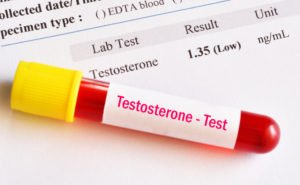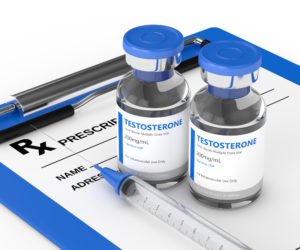
In a high-stakes world, the last thing any of us can afford is a hormonal deficiency with symptoms that can negatively impact every aspect of our lives—from our physical and mental performance to moments of intimacy that we should be able to simply enjoy. However, that is exactly what millions of men and women are battling every day. It’s called low T, and it is quite real.
Fortunately, convenient testosterone replacement therapy (TRT) options make it treatable and allow patients to take back their best lives.
What Is Low T?
The T stands for testosterone—a hormone that our bodies need to function properly.
- In men, the testes—testicles—produce the male hormone testosterone. It’s what gives men typically masculine traits like the strength of dense muscle mass, a masculine voice, for example, and sexual drive and performance. It’s also involved in regulating bone mass, determining how the body metabolizes cholesterol and distributes fat, and helping the body produce red blood cells and sperm.[1]
- In women, the ovaries, the adrenal gland and surrounding tissues produce testosterone. Levels are considerably lower than male averages. However, those comparatively small amounts can play an important role in women’s sexual desire and physical response as well as muscle strength, endurance and mood.[2]
When the body is unable to produce adequate levels of testosterone for good health and well-being, the condition may be referred to as hypogonadism, androgen deficiency, low testosterone or simply low T.[1-4]
For a free consultation, call (305) 682-1818
What is Total Testosterone Versus Free Testosterone?
When discussing testosterone levels, most study results will differentiate between free testosterone and total testosterone. Testosterone travels in the blood in three ways:
- It can bind tightly to sex hormone-binding globulin proteins. The levels of these proteins rise with age.
- It can bind to albumin, also a protein, but the bond is weak, making the testosterone accessible to the body.
- It can travel freely.
What’s important to realize is that only the last two forms of testosterone are bioavailable or biologically active, so total testosterone numbers do not necessarily correlate to free or usable levels of testosterone.[5,24]
How Common Is Low T?
Low T affects an estimated 4 to 5 million men in the U.S.[6] Numbers are not as clear-cut for women, but estimates that take into account complaints like decreased libido, lack of physical arousal responses and everyday muscle weakness place the number in the millions as well.[2] What’s important to understand is that low T is a condition that can affect anyone simply because of how the body works and ages.
The pituitary gland is the control in our brains that tells the body how much testosterone to make, and when all systems are working properly, the body produces it.
- Testosterone levels are typically highest when we’re in our late teens and 20s.
- They can begin decreasing in our 30s.[5]
- By our 40s, as we age, our levels can continue to fall by one to two percent each year.[4]
- By the time men are age 65 or older, 60 percent of them have free testosterone levels that are below the normal levels of men in their 30s.[6]
Therefore, normal total and free testosterone levels can range significantly depending on a person’s age, sex and physical condition. Levels can even fluctuate daily, being higher in the morning and tapering off to a low in the evening.[5,15]
- For men, normal numbers can range from 280 to 1,100 nanograms per deciliter.
- For women, normal numbers can range from 15 to 70 nanograms per deciliter.
For reference, The American Urological Association identifies low blood testosterone for men as less than 300 nanograms per deciliter,[1] and guidelines published in the Journal of Urology identify low total testosterone levels as less than 25 for women under 50 and less than 20 for women 50 or older.[2]
Click to contact our specialist today
Who Is At Risk for Low T?
By age 40, testosterone levels begin to fall for most men. While the decline is often gradual and nearly imperceptible, by age 70, testosterone production drops an average 30 percent from its peak.[15] One study found that nearly 40 percent of men 45 or older presenting to a primary care physician suffered from inadequate testosterone levels.[7] While anyone can begin feeling the effects of low T—especially with age—certain other conditions are also closely associated with it:
- Obesity—A BMI or body mass index between 25 and 30 is considered overweight while a BMI of 30 or greater is considered obese. Men carrying excess weight were more than twice as likely to also have low T. In fact, as weight goes up, testosterone levels go down. [7,8,23]
- Hypertension—High blood pressure nearly doubled the likelihood of low T, increasing the odds by 1.84.[7]
- Hyperlipidaemia—Men with high cholesterol or triglycerides were one and a half times more likely to also have low T.[7]
- Diabetes—Men with type 2 diabetes, metabolic syndrome and obesity typically have low T. Meanwhile, low T also seems to predispose men to develop type 2 diabetes, metabolic syndrome and obesity. Men with diabetes had double the risk of having low T.[7,9]
- Prostate Disease—The most common forms are prostatitis, enlarged prostate and prostate cancer. A University of Oxford study found that while men with low T were less likely to develop prostate cancer, if they did get it, it was an extremely aggressive form of prostate cancer.[10]
- Asthma and COPD, Chronic Obstructive Pulmonary Disease—Testosterone helps to control certain white blood cells that otherwise play a role in asthma and airway inflammation. Women are more likely to suffer these diseases than men, and men with low T are 1.4 times more likely to get them than men with adequate testosterone levels.[7,11]
Additional studies have linked low T levels with other serious health problems like anemia, depression, vascular aging, bone density loss and osteoporosis, cardiovascular events, and cognitive decline as well as HIV—Human Immunodeficiency Virus. [12,13,14,16,17,18,19]
Complete a Free Consultation form now
What Are the Symptoms of Low T?
As testosterone production gradually slows, symptoms of low T may likewise gradually creep up on us—signs that we at first fail to recognize but that become ever-more problematic over time. Some can even mimic other medical issues or intensify if other conditions are present. Common signs of low T can affect both men and women and can include [5,20,21]:
- a lack of sexual desire or decrease in libido;
- problems getting or maintaining an erection or a lack of physical response;
- weaker erections, milder orgasms, and lowered levels of semen or vaginal lubricant;
- fertility problems or reduced sperm counts;
- missed periods or irregular periods for women;
- changes in the testicles;
- fatigue and lack of energy;
- inability to sleep or sleep interruptions;
- irritability and mood changes;
- trouble concentrating, remembering or completing cognitive tasks;
- depression, lack of interest, lack of motivation or hopelessness;
- sweating or flushing;
- the development of breasts in men or changes in breast tissue for women;
- reduced strength and muscle mass;
- weight gain and accumulations of fat, especially belly fat;
- loss of body hair;
- low blood counts;
- decreased bone density and osteoporosis.
The symptoms of low T can be gradual and subtle. At the same time, they can be associated with any number of serious medical conditions. Learning whether your body is producing enough testosterone to keep you healthy and where you are on the low T spectrum can be the key to restoring or—equally important—maintaining your physical and mental health, well-being and quality of life.
The first step is as simple as a blood test.
What Is Testosterone Replacement Therapy—TRT?
If you find that you are indeed suffering from low T, the next step is to consider whether you’re a good candidate for testosterone replacement therapy, also known as TRT. Designed to reverse the effects of low T, replacement therapies are available in a number of delivery methods and dosages that can be customized specifically to you:[1,4,6]
- Gels are topically applied regularly to the skin, often the upper arms, shoulders or thigh area.
- Patches can be applied inconspicuously to slowly release a gradual dose of testosterone over time.
- Slow-release capsules or tablets are a form of oral therapy typically applied twice daily to the gum or cheek.
- Implants use small pellets. Placed under the skin at the hip or buttock, they slowly release testosterone over longer time periods of three to six months.
- Injections last two to four weeks but deliver an entire dose of testosterone in one shot.
Your level of low T, your lifestyle, your expectations, your physical condition and any other medical issues you may have are instrumental in determining the most convenient and effective type of replacement therapy for you. Keep in mind that some people can experience side effects like acne, sleep disturbances or swelling of the ankles, for example, and that an effective testosterone therapy plan requires constant monitoring and a willingness to work honestly with your care provider.[22] Our goal is to develop a testosterone replacement therapy plan that ensures the benefits to you are great and that any drawbacks remain small and manageable.
Can Testosterone Replacement Therapy Restore Quality of Life?
Simply learning whether low T is the source of your problems can be a huge step in reclaiming your quality of life. If it is, finding a solution through replacement therapy can give you the means of restoring your vitality and focus, maintaining your overall health and longevity, and rediscovering the excitement and pleasure so essential to intimate partnerships.
Most people start experiencing improvements in many symptoms in four to six weeks. However, some more intensive issues like rebuilding muscle mass, for example, can take months.[2,4] Over the long term, studies continue to explore whether testosterone therapies may even offer preventive properties to protect against degenerative conditions like osteoporosis and cognitive decline.
If you are experiencing symptoms typical of low T or suspect that falling testosterone levels are holding you back from all you were meant to accomplish, reach out to us at HealthGAINS. Contact us online, or call us at (305) 682-1818.
Yes, low T is real, but so are the benefits of testosterone replacement therapy.
References:
- https://www.urologyhealth.org/urologic-conditions/low-testosterone
- https://www.bumc.bu.edu/sexualmedicine/publications/testosterone-insufficiency-in-women-fact-or-fiction/ low T in women
- https://www.nih.gov/news-events/nih-research-matters/understanding-how-testosterone-affects-men#:~:text=Testosterone%20is%20a%20sex%20hormone,estradiol%2C%20a%20form%20of%20estrogen.
- https://www.health.harvard.edu/mens-health/treating-low-testosterone-levels
- https://www.urmc.rochester.edu/encyclopedia/content.aspx?contenttypeid=167&contentid=testosterone_total
- https://www.bumc.bu.edu/sexualmedicine/publications/prevalence-diagnosis-and-treatment-of-hypogonadism-in-primary-care-practice/#:~:text=Hypogonadism%20affects%20an%20estimated%204,men%20aged%2030%20to%2035.
- https://www.ncbi.nlm.nih.gov/pmc/articles/PMC1569444/
- https://www.cdc.gov/obesity/adult/defining.html#:~:text=If%20your%20BMI%20is%2018.5,falls%20within%20the%20obese%20range.
- https://care.diabetesjournals.org/content/34/7/1669?sms_ss=twitter&at_xt=4dcbf8dfb8fb9654%2C0
- https://prostatecanceruk.org/about-us/news-and-views/2017/11/testosterone-and-prostate-cancer-risk-the-plot-thickens
- https://lungdiseasenews.com/2017/12/07/link-between-testosterone-asthma-seen-in-study-explains-sex-differences-in-adults/
- Root source https://www.cell.com/cell-reports/pdf/S2211-1247(17)31590-5.pdf
- Anemia in men and women—”low*testosterone levels could be a susceptibility factor for anemia” https://jamanetwork.com/journals/jamainternalmedicine/article-abstract/410603 (remove * after “low — inserted due to keyword count
- Depression—”Men with low testosterone levels had a greater 2-year incidence of depressive illness (18.5% vs. 10.4%, df = 1, p = .006) and a shorter time to onset of depressive illness” https://psycnet.apa.org/record/2005-00996-002
- Aortic stiffness and vascular age—”Younger patients with testosterone deficiency have higher vascular age.” https://www.sciencedirect.com/science/article/abs/pii/S0021915013007636
- https://www.health.harvard.edu/newsletter_article/testosterone_aging_and_the_mind
- https://www.hcplive.com/view/testosterone-levels-and-bone-density-show-strong-connection
- https://www.onlinejacc.org/content/58/16/1674.abstract
- https://www.tandfonline.com/doi/abs/10.1080/13685530601040679
- https://www.hcplive.com/view/link-shown-between-men-with-hiv-and-low-testosterone
- https://www.betterhealth.vic.gov.au/health/conditionsandtreatments/androgen-deficiency-in-men#:~:text=Androgen%20deficiency%20means%20the%20body,treated%20with%20testosterone%20replacement%20therapy.
- https://www.healthline.com/health/low-testosterone/warning-signs#outlook
- https://www.health.harvard.edu/mens-health/is-testosterone-therapy-safe-take-a-breath-before-you-take-the-plunge
- https://www.health.harvard.edu/mens-health/a-new-look-at-testosterone-therapy
- https://www.mayocliniclabs.com/test-catalog/Clinical+and+Interpretive/83686
Call or text (305) 682-1818 or complete a Free Consultation Form








